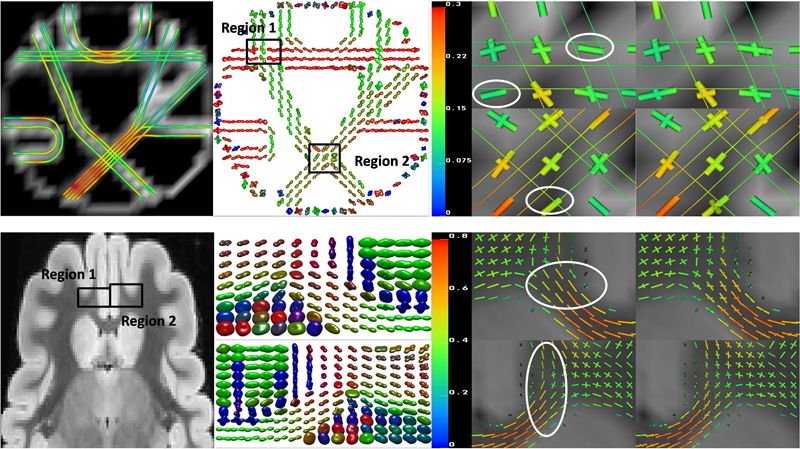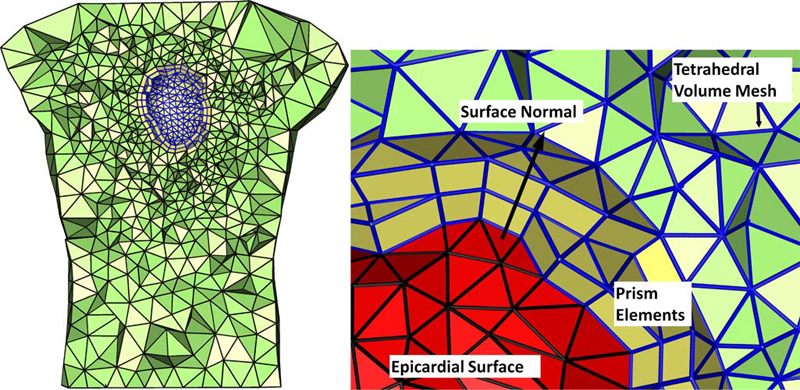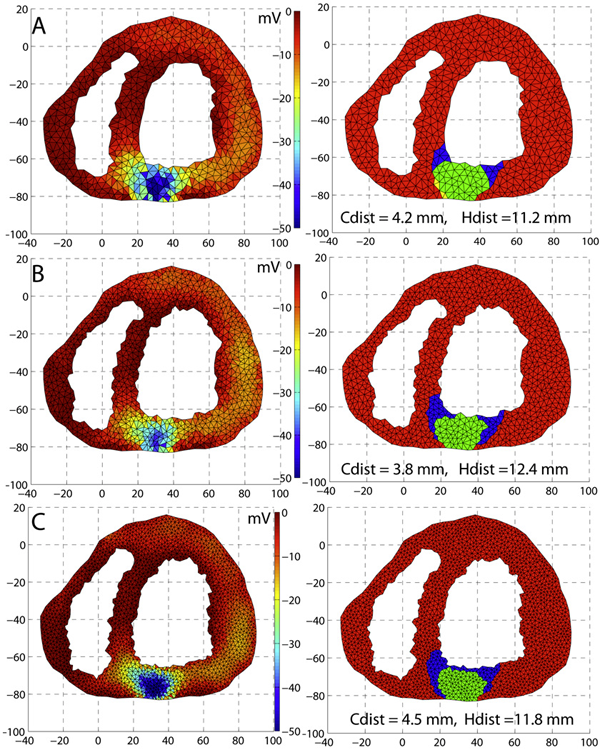SCI Publications
2012
P.C. Wong, H.-W. Shen, C.R. Johnson, C. Chen, R.B. Ross.
“The Top 10 Challenges in Extreme-Scale Visual Analytics,” In IEEE Computer Graphics and Applications, pp. 63--67. July-August, 2012.
DOI: 10.1109/MCG.2012.87
PubMed ID: 24489426
PubMed Central ID: PMC3907777
In this issue of CG&A, researchers share their R&D findings and results on applying visual analytics (VA) to extreme-scale data. Having surveyed these articles and other R&D in this field, we've identified what we consider the top challenges of extreme-scale VA. To cater to the magazine's diverse readership, our discussion evaluates challenges in all areas of the field, including algorithms, hardware, software, engineering, and social issues.
Keywords: scidac, Large-scale systems, Visual analytics, computer graphics, extreme-scale visual analytics, high-performance computing, interaction, large-data visualization, user interfaces, visual analytics
2011
F. Jiao, Y. Gur, C.R. Johnson, S. Joshi.
“Detection of crossing white matter fibers with high-order tensors and rank-k decompositions,” In Proceedings of the International Conference on Information Processing in Medical Imaging (IPMI 2011), Lecture Notes in Computer Science (LNCS), Vol. 6801, pp. 538--549. 2011.
DOI: 10.1007/978-3-642-22092-0_44
PubMed Central ID: PMC3327305

D. Keyes, V. Taylor, T. Hey, S. Feldman, G. Allen, P. Colella, P. Cummings, F. Darema, J. Dongarra, T. Dunning, M. Ellisman, I. Foster, W. Gropp, C.R. Johnson, C. Kamath, R. Madduri, M. Mascagni, S.G. Parker, P. Raghavan, A. Trefethen, S. Valcourt, A. Patra, F. Choudhury, C. Cooper, P. McCartney, M. Parashar, T. Russell, B. Schneider, J. Schopf, N. Sharp.
“Advisory Committee for CyberInfrastructure Task Force on Software for Science and Engineering,” Note: NSF Report, 2011.
The Software for Science and Engineering (SSE) Task Force commenced in June 2009 with a charge that consisted of the following three elements:
Identify specific needs and opportunities across the spectrum of scientific software infrastructure. Characterize the specific needs and analyze technical gaps and opportunities for NSF to meet those needs through individual and systemic approaches. Design responsive approaches. Develop initiatives and programs led (or co-led) by NSF to grow, develop, and sustain the software infrastructure needed to support NSF’s mission of transformative research and innovation leading to scientific leadership and technological competitiveness. Address issues of institutional barriers. Anticipate, analyze and address both institutional and exogenous barriers to NSF’s promotion of such an infrastructure.The SSE Task Force members participated in bi-weekly telecons to address the given charge. The telecons often included additional distinguished members of the scientific community beyond the task force membership engaged in software issues, as well as personnel from federal agencies outside of NSF who manage software programs. It was quickly acknowledged that a number of reports loosely and tightly related to SSE existed and should be leveraged. By September 2009, the task formed had formed three subcommittees focused on the following topics: (1) compute-intensive science, (2) data-intensive science, and (3) software evolution.
J. Mandel, J.D. Beezley, A. Kochanski, V.Y. Kondratenko, L. Zhang, E. Anderson, J. Daniels II, C.T. Silva, C.R. Johnson.
“A wildland fire modeling and visualization environment,” In Proceedings of the Ninth Symposium on Fire and Forest Meteorology, pp. (published online). 2011.
J.T. Oden, O. Ghattas, J.L. King, B.I. Schneider, K. Bartschat, F. Darema, J. Drake, T. Dunning, D. Estep, S. Glotzer, M. Gurnis, C.R. Johnson, D.S. Katz, D. Keyes, S. Kiesler, S. Kim, J. Kinter, G. Klimeck, C.W. McCurdy, R. Moser, C. Ott, A. Patra, L. Petzold, T. Schlick, K. Schulten, V. Stodden, J. Tromp, M. Wheeler, S.J. Winter, C. Wu, K. Yelick.
“Cyber Science and Engineering: A Report of the National Science Foundation Advisory Committee for Cyberinfrastructure Task Force on Grand Challenges,” Note: NSF Report, 2011.
This document contains the findings and recommendations of the NSF – Advisory Committee for Cyberinfrastructure Task Force on Grand Challenges addressed by advances in Cyber Science and Engineering. The term Cyber Science and Engineering (CS&E) is introduced to describe the intellectual discipline that brings together core areas of science and engineering, computer science, and computational and applied mathematics in a concerted effort to use the cyberinfrastructure (CI) for scientific discovery and engineering innovations; CS&E is computational and data-based science and engineering enabled by CI. The report examines a host of broad issues faced in addressing the Grand Challenges of science and technology and explores how those can be met by advances in CI. Included in the report are recommendations for new programs and initiatives that will expand the portfolio of the Office of Cyberinfrastructure and that will be critical to advances in all areas of science and engineering that rely on the CI.
T.A. Quinn, S. Granite, M.A. Allessie, C. Antzelevitch, C. Bollensdorff, G. Bub, R.A.B. Burton, E. Cerbai, P.S. Chen, M. Delmar, D. DiFrancesco, Y.E. Earm, I.R. Efimov, M. Egger, E. Entcheva, M. Fink, R. Fischmeister, M.R. Franz, A. Garny, W.R. Giles, T. Hannes, S.E. Harding, P.J. Hunter, s, G. Iribe, J. Jalife, C.R. Johnson, R.S. Kass, I. Kodama, G. Koren, P. Lord, V.S. Markhasin, S. Matsuoka, A.D. McCulloch, G.R. Mirams, G.E. Morley, S. Nattel, D. Noble, S.P. Olesen, A.V. Panfilov, N.A. Trayanova, U. Ravens, S. Richard, D.S. Rosenbaum, Y. Rudy, F. Sachs, F.B. Sachse, D.A. Saint, U. Schotten, O. Solovyova, P. Taggart, L. Tung, A. Varrò, P.G. Volders, K. Wang, J.N. Weiss, E. Wettwer, E. White, R. Wilders, R.L. Winslow, P. Kohl.
“Minimum Information about a Cardiac Electrophysiology Experiment (MICEE): Standardised reporting for model reproducibility, interoperability, and data sharing,” In Progress in Biophysics and Molecular Biology, Vol. 107, No. 1, Elsevier, pp. 4--10. October, 2011.
DOI: 10.1016/j.pbiomolbio.2011.07.001
PubMed Central ID: PMC3190048
Cardiac experimental electrophysiology is in need of a well-defined Minimum Information Standard for recording, annotating, and reporting experimental data. As a step toward establishing this, we present a draft standard, called Minimum Information about a Cardiac Electrophysiology Experiment (MICEE). The ultimate goal is to develop a useful tool for cardiac electrophysiologists which facilitates and improves dissemination of the minimum information necessary for reproduction of cardiac electrophysiology research, allowing for easier comparison and utilisation of findings by others. It is hoped that this will enhance the integration of individual results into experimental, computational, and conceptual models. In its present form, this draft is intended for assessment and development by the research community. We invite the reader to join this effort, and, if deemed productive, implement the Minimum Information about a Cardiac Electrophysiology Experiment standard in their own work.
Keywords: Minimum Information Standard; Cardiac electrophysiology; Data sharing; Reproducibility; Integration; Computational modelling
R. Samuel, H.J. Sant, F. Jiao, C.R. Johnson, B.K. Gale.
“Microfluidic laminate-based phantom for diffusion tensor-magnetic resonance imaging,” In Journal of Micromech. Microeng., Vol. 21, pp. 095027--095038. 2011.
DOI: 10.1088/0960-1317/21/9/095027
D. Wang, R.M. Kirby, C.R. Johnson.
“Finite Element Based Discretization and Regularization Strategies for 3D Inverse Electrocardiography,” In IEEE Transactions for Biomedical Engineering, Vol. 58, No. 6, pp. 1827--1838. 2011.
PubMed ID: 21382763
PubMed Central ID: PMC3109267

D. Wang, R.M. Kirby, R.S. Macleod, C.R. Johnson.
“An optimization framework for inversely estimating myocardial transmembrane potentials and localizing ischemia,” In Proceedings of the International Conference of the IEEE Engineering in Medicine and Biology Society (EMBS), pp. 1680--1683. 2011.
DOI: 10.1109/IEMBS.2011.6090483
PubMed ID: 22254648
PubMed Central ID: PMC3336368

2010
F. Jiao, J.M. Phillips, J.G. Stinstra, J. Kueger, R. Varma, E. Hsu, J. Korenberg, C.R. Johnson.
“Metrics for Uncertainty Analysis and Visualization of Diffusion Tensor Images,” In Proceedings of the 5th international conference on Medical imaging and augmented reality (MIAR), Beijing, China, Springer-Verlag, Berlin, Heidelberg pp. 179--190. September, 2010.
K. Potter, J.M. Kniss, R. Riesenfeld, C.R. Johnson.
“Visualizing Summary Statistics and Uncertainty,” In Computer Graphics Forum, Vol. 29, No. 3, Wiley-Blackwell, pp. 823--831. Aug, 2010.
A.A. Samsonov, J.V. Velikina, Y.K. Jung, E.G. Kholmovski, C.R. Johnson, W.F. Block.
“POCS-enhanced correction of motion artifacts in parallel MRI,” In Magnetic Resonance in Medicine, Vol. 63, No. 4, pp. 1104--1110. May, 2010.
A. van Dam, J. Foley, J. Guttag, P. Hanrahan, C.R. Johnson, R. Katz, H. Kelly, P. Lee, D.E. Shaw.
“CRA-E White Paper: Creating Environments for Computational Researcher Education,” Note: Computing Research Association (CRA), August, 2010.
D.F. Wang, R.M. Kirby, C.R. Johnson.
“Resolution Strategies for the Finite-Element-Based Solution of the ECG Inverse Problem,” In IEEE Transactions on Biomedical Engineering, Vol. 57, No. 2, pp. 220--237. February, 2010.
D.F. Wang, R.M. Kirby, R.S. MacLeod, C.R. Johnson.
“A New Family of Variational-Form-Based Regularizers for Reconstructing Epicardial Potentials from Body-Surface Mapping,” In Computing in Cardiology, 2010, pp. 93--96. 2010.
2009
E.W. Bethel, C.R. Johnson, S. Ahern, J. Bell, P.-T. Bremer, H. Childs, E. Cormier-Michel, M. Day, E. Deines, P.T. Fogal, C. Garth, C.G.R. Geddes, H. Hagen, B. Hamann, C.D. Hansen, J. Jacobsen, K.I. Joy, J. Krüger, J. Meredith, P. Messmer, G. Ostrouchov, V. Pascucci, K. Potter, Prabhat, D. Pugmire, O. Rubel, A.R. Sanderson, C.T. Silva, D. Ushizima, G.H. Weber, B. Whitlock, K. Wu.
“Occam's Razor and Petascale Visual Data Analysis,” In Journal of Physics: Conference Series, Journal of Physics: Conference Series, Vol. 180, No. 012084, pp. (published online). 2009.
DOI: 10.1088/1742-6596/180/1/012084
One of the central challenges facing visualization research is how to effectively enable knowledge discovery. An effective approach will likely combine application architectures that are capable of running on today's largest platforms to address the challenges posed by large data with visual data analysis techniques that help find, represent, and effectively convey scientifically interesting features and phenomena.
M. Callahan, M.J. Cole, J.F. Shepherd, J.G. Stinstra, C.R. Johnson.
“A Meshing Pipeline for Biomedical Models,” In Engineering with Computers, Vol. 25, No. 1, SpringerLink, pp. 115-130. 2009.
DOI: 10.1007/s00366-008-0106-1
M. Ellisman, R. Stevens, M. Colvin, T. Schlick, E. Delong, G. Olsen, J. George, G. Karniakadis, C.R. Johnson, N. Sematova.
“Scientific Grand Challenges: Opportunities in biology at the Extreme Scale of Computing,” Note: DOE Office of Advanced Scientific Computing Research, August, 2009.
C.D. Hansen, C.R. Johnson, V. Pascucci, C.T. Silva.
“Visualization for Data-Intensive Science,” In The Fourth Paradigm: Data-Intensive Science, Edited by S. Tansley and T. Hey and K. Tolle, Microsoft Research, pp. 153--164. 2009.
R.S. MacLeod, J.G. Stinstra, S. Lew, R.T. Whitaker, D.J. Swenson, M.J. Cole, J. Krüger, D.H. Brooks, C.R. Johnson.
“Subject-specific, multiscale simulation of electrophysiology: a software pipeline for image-based models and application examples,” In Philosophical Transactions of The Royal Society A, Mathematical, Physical & Engineering Sciences, Vol. 367, No. 1896, pp. 2293--2310. 2009.
Page 5 of 15
